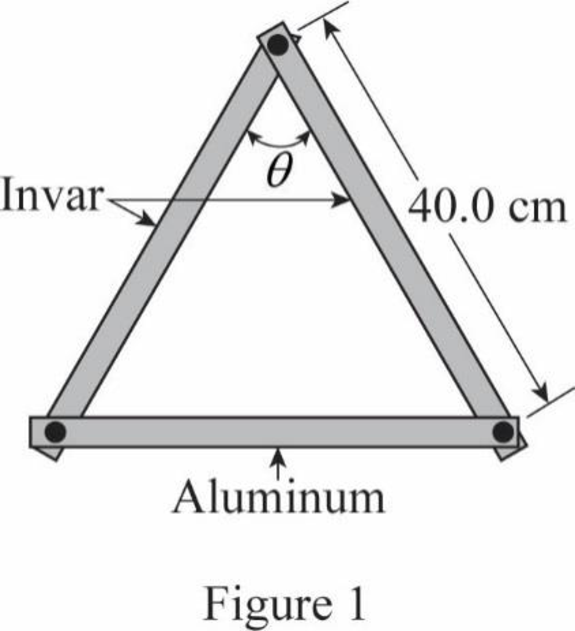
(a)
The angle between the invar bars.
(a)
Answer to Problem 54AP
The angle between the invar bars is
Explanation of Solution
The diagram for the three metal bars is depicted below.

Write the equation angle from trigonometry.
Here,
Write the equation for the final length.
Here,
Conclusion:
Substitute
Thus, the angle between the invar bars is
(b)
The value of angle is accurate for both negative and positive temperature or not.
(b)
Answer to Problem 54AP
Yes, the value of angle is accurate for both negative and positive temperature.
Explanation of Solution
If the temperature difference positive or negative, it will not affect the value of angle.
If the temperature is positive, the bar will expand. As well as the temperature i negative, the bar will have contraction.
Thus, the value of angle is accurate for both negative and positive temperature.
(c)
The value of angle is accurate for zero degree temperature or not.
(c)
Answer to Problem 54AP
Yes, the value of angle is accurate for zero degree temperature.
Explanation of Solution
Write the expression for the angle.
At,
Thus, the value of angle is accurate for zero degree temperature.
(d)
The angle between the invar bars when the invar also expand.
(d)
Answer to Problem 54AP
The angle between the invar bars when the invar also expand is
Explanation of Solution
Refer Figure 1.
Write the equation angle from trigonometry.
Here,
Write the equation for the final length of the aluminium.
Here,
Write the equation for the final length of the invar.
Here,
Conclusion:
Substitute
Thus, the angle between the invar bars when the invar also expand is
(e)
The greatest value of angle between the invar bars.
(e)
Answer to Problem 54AP
The greatest value of angle between the invar bars is
Explanation of Solution
Write the equation for the angle
Conclusion:
Substitute
Thus, the greatest value of angle between the invar bars is
(f)
The smallest value of angle between the invar bars.
(f)
Answer to Problem 54AP
The smallest value of angle between the invar bars is
Explanation of Solution
Write the equation for the angle
Conclusion:
Substitute
Thus, The smallest value of angle between the invar bars is
Want to see more full solutions like this?
Chapter 19 Solutions
Physics for Scientists and Engineers with Modern, Revised Hybrid (with Enhanced WebAssign Printed Access Card for Physics, Multi-Term Courses)
- Pls help asaparrow_forwardPls help asaparrow_forward3. If the force of gravity stopped acting on the planets in our solar system, what would happen? a) They would spiral slowly towards the sun. b) They would continue in straight lines tangent to their orbits. c) They would continue to orbit the sun. d) They would fly straight away from the sun. e) They would spiral slowly away from the sun. 4. 1 The free-body diagram of a wagon being pulled along a horizontal surface is best represented by A F N B C 0 Ꭰ FN E a) A b) B c) C app app The app 10 app d) e) ס ח D E 10 apparrow_forward
- The acceleration of an object sliding along a frictionless ramp is inclined at an angle 0 is 9. a) g tano b) g cose c) g sino 10. d) g e) zero A 1.5 kg cart is pulled with a force of 7.3 N at an angle of 40° above the horizontal. If a kinetic friction force of 3.2 N acts against the motion, the cart's acceleration along the horizontal surface will be a) 5.0 m/s² b) 1.6 m/s² c) 2.4 m/s² 11. d) 1.0 m/s² e) 2.7 m/s² What is the net force acting on an object with a mass of 10 kg moving at a constant velocity of 10 m/s [North]? a) 100 N [North] b) 100 N [South] 10 N [North} d) 10 N [South] e) None of these.arrow_forwardModified True/False - indicate whether the sentence or statement is true or false. If the statement is false, correct the statement to make it true. 12. An object in uniform circular motion has a constant velocity while experiencing centripetal acceleration. 13. An object travelling in uniform circular motion experiences an outward centrifugal force that tends to pull the object out of the circular path. 14. An object with less inertia can resist changes in motion more than an object with more inertia. 15. For an object sliding on a horizontal surface with a horizontal applied force, the frictional force will always increase as the applied force increases.arrow_forwardPls help asaparrow_forward
 Physics for Scientists and Engineers: Foundations...PhysicsISBN:9781133939146Author:Katz, Debora M.Publisher:Cengage Learning
Physics for Scientists and Engineers: Foundations...PhysicsISBN:9781133939146Author:Katz, Debora M.Publisher:Cengage Learning College PhysicsPhysicsISBN:9781285737027Author:Raymond A. Serway, Chris VuillePublisher:Cengage Learning
College PhysicsPhysicsISBN:9781285737027Author:Raymond A. Serway, Chris VuillePublisher:Cengage Learning Physics for Scientists and Engineers, Technology ...PhysicsISBN:9781305116399Author:Raymond A. Serway, John W. JewettPublisher:Cengage Learning
Physics for Scientists and Engineers, Technology ...PhysicsISBN:9781305116399Author:Raymond A. Serway, John W. JewettPublisher:Cengage Learning Principles of Physics: A Calculus-Based TextPhysicsISBN:9781133104261Author:Raymond A. Serway, John W. JewettPublisher:Cengage Learning
Principles of Physics: A Calculus-Based TextPhysicsISBN:9781133104261Author:Raymond A. Serway, John W. JewettPublisher:Cengage Learning College PhysicsPhysicsISBN:9781305952300Author:Raymond A. Serway, Chris VuillePublisher:Cengage Learning
College PhysicsPhysicsISBN:9781305952300Author:Raymond A. Serway, Chris VuillePublisher:Cengage Learning Physics for Scientists and EngineersPhysicsISBN:9781337553278Author:Raymond A. Serway, John W. JewettPublisher:Cengage Learning
Physics for Scientists and EngineersPhysicsISBN:9781337553278Author:Raymond A. Serway, John W. JewettPublisher:Cengage Learning





